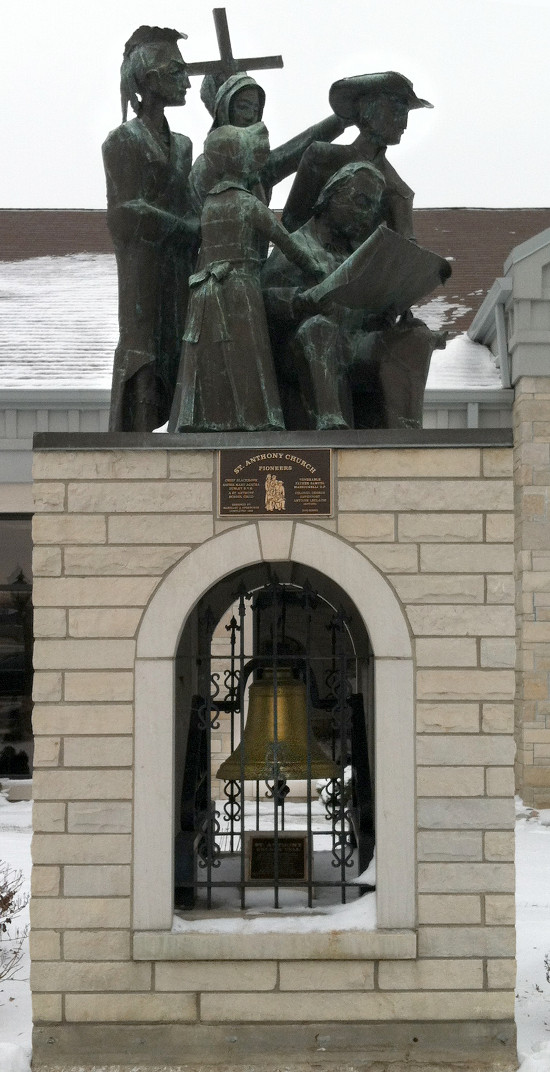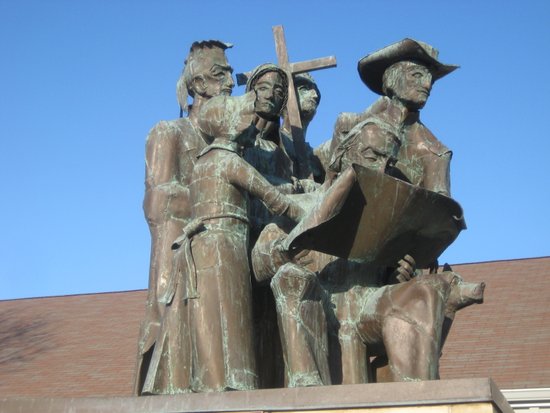In 1989, Donna Marihart and Ann Opgenorth completed a brazed-copper sculpture for the 150th anniversary of St. Anthony Catholic Church (417 Main Street in Davenport), the oldest standing church building in Iowa. Titled St. Anthony Church Pioneers, the sculpture depicts a group of men and women who contributed to the founding of the church and the City of Davenport. The composition as a whole creates a sense of community.
The figures are gathered behind a portrayal of a seated Antoine LeClaire (1797-1861), who is holding an open plan or map. LeClaire donated the land on which the church was built.
The other figures are:
• Black Hawk, Sauk leader (1767-1838), who was defeated in war in 1832. The City of Davenport was founded four years after the war's treaty ceded the Sauk land west of the Mississippi River.
• Colonel George Davenport (1783-1845), who planned the City of Davenport along with LeClaire.
• Father Samuel Mazzuchelli (1806-1864), a missionary Dominican priest who founded and designed the church. In the course of his life, he would found 30 parishes in Iowa, Illinois, and Wisconsin and design and build more than 20 church buildings.
• Sister Mary Agatha Hurley (1826-1902) of the Sisters of Charity of the Blessed Virgin Mary, who served as the first principal at St. Anthony's School - beginning in 1855. She is shown standing with a young student.
At these figures' feet is a dog modeled after Bingo, who belonged to Father James Conroy - the pastor at St. Anthony's when the sculpture was constructed. The good-natured inclusion of Bingo subtly links 150 years of history; the dog stands in the sculpture not with his owner but with the church's founder.
Working together, Marihart and Opgenorth constructed the sculpture at their studio in Bellevue, Iowa. The technique they used emphasizes the sheets of copper and their welded edges. The resulting abstracted forms and textured surface give the work its more universal - even aspirational - quality. Its rough-hewn surface creates a sense that things have not yet taken final form. One focuses on the collective rhythms and gestures of the work rather than the individual features or even individual forms.
The figures -approximately 4 feet in height - were made separately in the studio's welding shop, but the sculpture was finalized in the driveway, as the completed piece was too large to fit through the doorway. The sculpture's base is roughly 5 feet square.
Built into the base is an enclosure with the church's original bell. It called parishioners to mass and children to school. It was also used for the court of justice, fire alarms, public forums, and civic and social gatherings. The bell is a symbol of the church, but also of the whole community - not unlike the disparate yet tightly gathered group of figures above.

Bruce Walters is a professor of art at Western Illinois University.
This is part of an occasional series on the history of public art in the Quad Cities. If there's a piece of public art that you'd like to learn more about, e-mail the location and a brief description to BD-Walters@wiu.edu.











